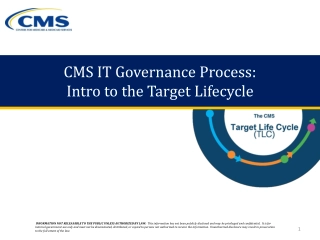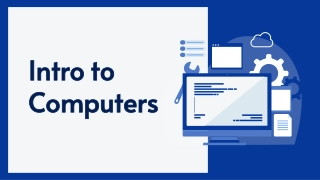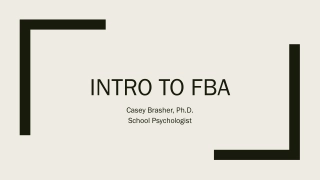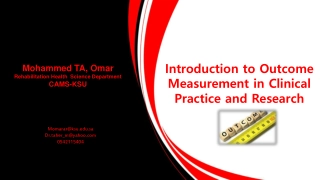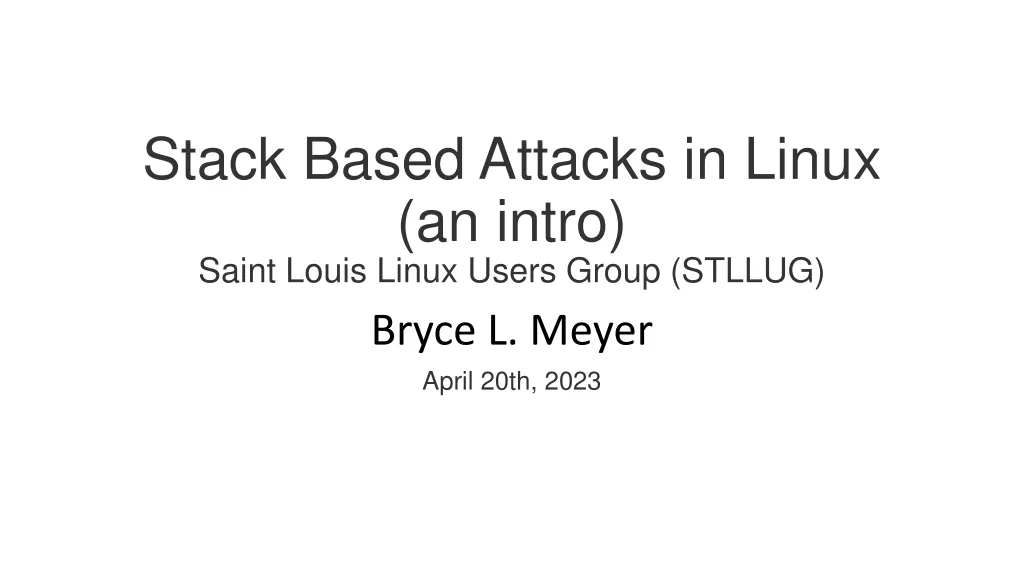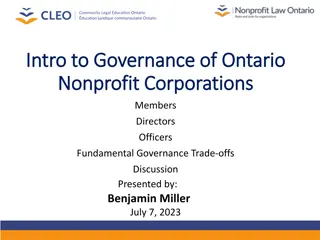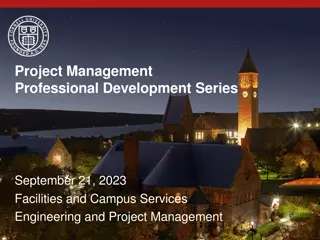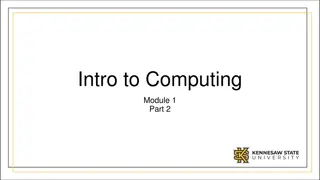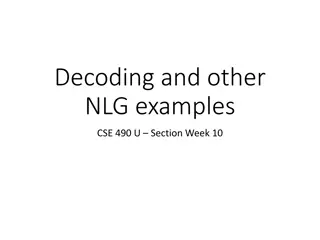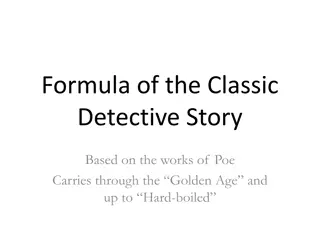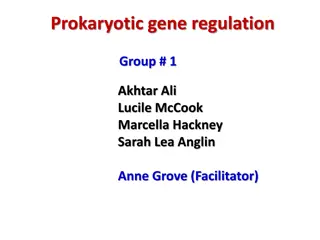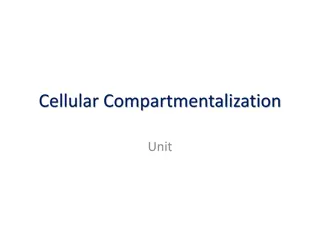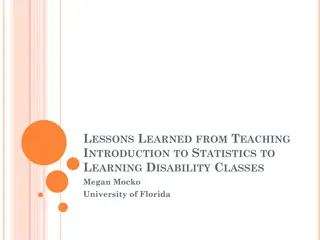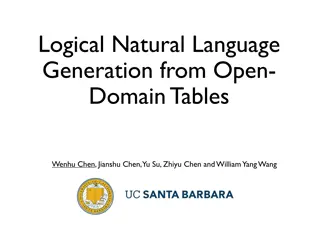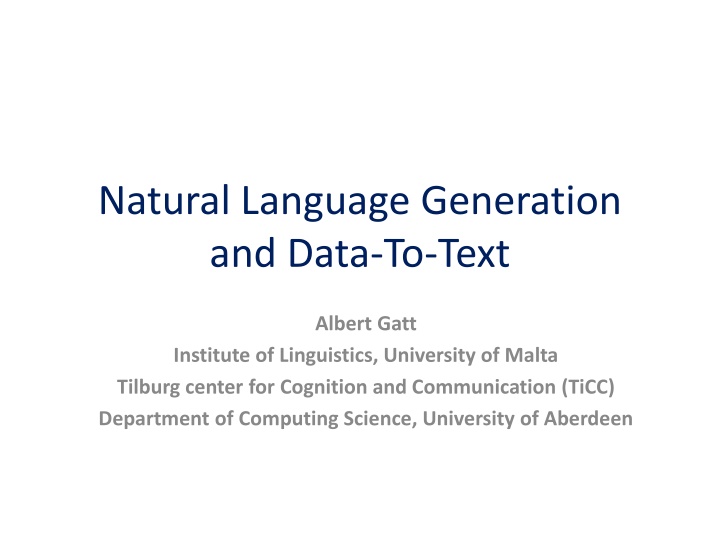
Understanding Natural Language Generation (NLG)
Delve into the concept of Natural Language Generation (NLG), where computer software creates coherent text to achieve specific communication goals. Explore the sub-tasks, challenges, and evaluation methods in NLG, with a focus on document planning and time-sensitive narratives.
Uploaded on | 0 Views
Download Presentation

Please find below an Image/Link to download the presentation.
The content on the website is provided AS IS for your information and personal use only. It may not be sold, licensed, or shared on other websites without obtaining consent from the author. If you encounter any issues during the download, it is possible that the publisher has removed the file from their server.
You are allowed to download the files provided on this website for personal or commercial use, subject to the condition that they are used lawfully. All files are the property of their respective owners.
The content on the website is provided AS IS for your information and personal use only. It may not be sold, licensed, or shared on other websites without obtaining consent from the author.
E N D
Presentation Transcript
Natural Language Generation and Data-To-Text Albert Gatt Institute of Linguistics, University of Malta Tilburg center for Cognition and Communication (TiCC) Department of Computing Science, University of Aberdeen
Natural Language Generation (NLG) Natural language generation (NLG) is the process of deliberately constructing a natural language text in order to meet specified communicative goals. (McDonald 1992)
Aims of these lectures To introduce the field of NLG Main sub-tasks Architectures To introduce some of the challenges in going from non-linguistic data to relatively long, narrative texts Document planning Dealing with time To look at methodological issues in NLG evaluation using different methods: Evaluating large-scale systems with real users Evaluating Referring Expression Generation algorithms As a running example, we ll often be looking at a recent family of systems developed as part of the BabyTalk Project.
Part 1 NLG AND CHOICE
What is NLG? Goal: computer software which produces understandable and appropriate texts in human language Input: Some non-linguistic representation of information (structured KB, numerical data ) The goal that the system has to satisfy (e.g. inform the user) Output: documents, reports, explanations, help messages, and other kinds of texts Knowledge sources required: Knowledge of language (lexicon, grammar) Knowledge of the domain (types of entities and events, their properties, etc) 5
Uses of NLG (examples) Informational: Automatic generation of weather reports Producing medical summaries from patient histories. Entertainment: Automatic generation of stories, jokes etc. Interaction: Dialogue agents that help users achieve a task. Assistive technology: Aids for people with special communication needs. 6
What is involved? Suppose someone produces the following utterance: Today the temperature will be 25 degrees on average. What are the steps required to produce this utterance? 7
Steps in language production Today the temperature will be 25 degrees on average. 1. Communicative goal/intention Inform the reader 2. Formulation (conceptualisation) Deciding what to say 3. Encoding: a. Choice of words b. Choice of grammatical construction 8
Steps in language production Today the temperature will be 25 degrees on average. 4. Realising the message Ensuring syntactic correctness Applying morphological rules 5. Mapping to speech output (or writing) 9
The main task The main problem for a speaker (and for an NLG system) is choice Let s unpack some of the choices. 10
Choice in language generation Content determination Given a communicative intention, the generator needs to decide: What is relevant What the addressee knows (or not) What is easily inferrable (and can therefore be left unsaid) 11
Choice in language production Lexicalisation: Choice of words Humans have a vast lexicon at their disposal. Word choice can be impacted by a host of factors: The addressee (will he understand a particular word?) The genre and context (is this appropriate in the context?) The speaker s personality. 12
Choice in language production Lexicalisation: Choice of words Today the temperature will be 25 degrees on average. Today the temperature will be roughly 25 degrees. Today, the temperature will average around 25 degrees. Today, it will be warm. 13
Choice in language production Realisation: choosing grammatical structures Partly dependent on the words chosen. But also on many other factors, including desired style, context etc. Today the temperature will average 25 degrees. Today the average temperature will be 25 degrees. Today it ll be warm. 14
How are choices made? Some choices are simply consequences of the language or grammar (cf. Reiter 2010). I kicked myself. *I kicked me. The choice of pronoun is directly predictable from principles governing the use of reflexives. Other choices are less straightforward: I kicked him. Vs. I kicked Pete. Depends, among other things, on how salient the person called Pete is in the hearer s memory. 15
NLG and choice Like human speakers, NLG systems too are designed to make choices at every level. Systems differ in their degree of complexity. It is possible to hardwire shortcuts into the system to avoid complex choices. But full-blown NLG systems can become extremely complex. 16
Part 2 SOME EXAMPLES OF NLG SYSTEMS
Example System #1: FoG Function: Classic system that produces textual weather reports in English and French Input: Graphical/numerical weather depiction User: Environment Canada (Canadian Weather Service) Developer: CoGenTex Inc. See Goldberg et al (1994) 18
FoG: Input 19
FoG: Output 20
Example System #2: STOP Function: Produces a personalised smoking-cessation leaflet Input: Questionnaire about smoking attitudes, beliefs, history Developer: University of Aberdeen See: Reiter et al. (2003) 21
STOP: Input SMOKING QUESTIONNAIRE Please answer by marking the most appropriate box for each question like this: Q1 Have you smoked a cigarette in the last week, even a puff? YES Please complete the following questions NO Please return the questionnaire unanswered in the envelope provided. Thank you. Please read the questions carefully.If you are not sure how to answer, just give the best answer you can. Home situation: Live alone Q2 Live with husband/wife/partner Live with other adults Live with children Q3 Number of children under 16 living at home boys 1 . girls Does anyone else in your household smoke?(If so, please mark all boxes which apply) husband/wife/partner other family member Q4 others Q5 How long have you smoked for? 10 years Tick here if you have smoked for less than a year 22
STOP: Output Dear Ms Cameron Dear Ms Cameron Thank you for taking the trouble to return the smoking questionnaire that we sent you. It appears from your answers that although you're not planning to stop smoking in the near future, you would like to stop if it was easy. You think it would be difficult to stop because smoking helps you cope with stress, it is something to do when you are bored, and smoking stops you putting on weight. However, you have reasons to be confident of success if you did try to stop, and there are ways of coping with the difficulties. 23
Example System #3: STORYBOOOK Function: Produces a fairy tale for entertainment purposes Input: An abstract story plan Developer: Charles Callaway (part of a PhD project) See: Callaway and Lester (2002) 24
STORYBOOK: input (actor-property exist-being woodman001) (refinement and-along-with woodman001 (refinement belonging-to wife001 woodman001) (specification exist-being process-step-type once-upon-a-time) (...) wife001) 25
STORYBOOK: Output Once upon a time, there was a woodman and his wife who lived in a pretty cottage on the borders of a great forest. They had one little daughter, a sweet child, who was a favourite with everyone. She was the joy of her mother s heart, and to please her, the good woman made her a little scarlet cloak and hood. She looked so pretty in it that everyone called her Little Red Riding Hood.
Part 3 NLG TASKS AND ARCHITECTURES
The architecture of NLG systems There is widespread consensus on what NLG systems do (the tasks). There s more variation in how NLG systems are organised (the modules, input and output). We often speak of a consensus architecture which has been adopted in many systems. But many systems, especially statistical NLG systems, do not conform to this architecture. 28
Lexicalisation: The choice of content words to appear in the final output text. Aggregation: The combination of several structures (e.g., sentences) into a single, more complex, structure. Rhetorical structuring: The determination of rhetorical relations and their scope. Referring expression generation: Selection of content for referring expressions; Decision on the form of these expressions (pronoun, definite description). Ordering: The choice of linear ordering of the elements of the text. Segmentation: The dividing up of information into sentences and paragraphs. NLG core tasks RAGS project (Mellish et al, 2006) Identified several important tasks which are carried out by many systems. Based on an exhaustive survey of the state of the art. But how are these tasks organised?
A consensus architecture? Reiter (1994) and Reiter and Dale (2000) argued that the various tasks can be grouped in a three-stage pipeline. Their architecture represents a consensus view. But note that several systems do not conform to it. This is especially true of statistical NLG systems.
The consensus architecture Communicative goal A pipeline architecture highly modular Document Planner NB: Diagram does not show knowledge sources! Domain knowledge Lexical/grammatical knowledge Model of the user ... document plan Microplanner text specification Surface Realiser text
The consensus architecture Communicative goal Tasks: Selecting the messages to be included Rhetorical structuring Ordering Segmentation Document Planner document plan Tasks: Lexicalisation Referring Expression Generation Aggregation Microplanner text specification Tasks: Choosing syntactic structures Applying morphological rules Rendering the text as a string Surface Realiser text
NLG vs Automatic Summarisation Automatic summarisation systems generate summaries of one or more input documents. Most systems work by: Analysing the input documents to extract important sentences Carrying out some transformation on the result to render the text coherent Synthesising the sentences into a summary
NLG vs Automatic Summarisation I. Mani (2001). Automatic summarization. Amsterdam: John Benjamins There are some similarities between NLG and summarisation. But summarisation systems take text as a starting point. Extractive summarisers perform quite limited linguistic processing. Some of the transformation/synthesis tasks done by summarisation systems are the same as those done by NLG systems during microplanning. 34
Part 4 CASE STUDY: THE BABYTALK SYSTEMS
Extending the architecture Some NLG systems have to deal with raw, unstructured data. This means that prior to generating text, the data has to be analysed in order to: Identify the important things and filter out noise Map the data to appropriate input representations Perform some reasoning on these representations
Extending the architecture Reiter (2007) proposed to extend the consensus architecture to deal with preliminary stages of: 1. Signal analysis: to extract patterns and trends from unstructured input data; 2. Data interpretation: the perform reasoning on the results
BabyTalk Context Neonatal Intensive Care Unit (NICU), where patients: are typically preterm infants (e.g. 27 weeks) are monitored continuously so data is collected all the time. Problem A doctor or nurse needs to process the relevant parts of the data to make clinical decisions. Typical scenario Large datasets are investigated using some form of visualisation (graphs, time series, etc). 38
Data (I): continuous Oxygen Saturation (SO) ECG (HR) Peripheral Temperature (TP) Arterial Line (Blood Pressure) Transcutaneous Probe Core Temperature (TC) (CO2,O2) Each channel sampled at 1Hz 86,400 samples/channel/patient/day 40
Data (II): Sporadic (manual) Manually entered values Numeric: results of lab tests, etc Symbolic: type of respiratory support, drugs Currently displayed as a structured entry. 42
Data (III): Free text Notes entered periodically by nurses No structure Stable overnight Handling slightly better TPN ordered with extra potassium today Balance = +35mls, UO 2.7ml/kg/hr Ventilation unchanged - good gas overnight Morning bloods sent 43
Why isnt that enough? Previous research Nurses and doctors have trouble identifying important patterns in data; Long-term trends in a patient s health difficult to detect; Shift reports consist of disjointed items of information. (McIntosh et al `00; Alberdi et al `01) Law et al (2005): Off-ward experiment with doctors and nurses; 45 minutes of patient data, presented visually or in written form; Preference expressed for visualisations (the standard presentation format); Better decisions with summaries. 45
Data to Text Our question Can data-to-text NLG be used to summarise patient data in the NICU for decision support? The answer We think it can. This claim is based on the development and evaluation of the systems in the BabyTalk project. 46
BabyTalk Systems BabyTalk developed systems to summarise patient data. BT45 Prototype system to summarise 45 minutes worth of data from the NICU. BT-Nurse Large-scale system to summarise a whole shift (12 hrs) of data to help nurses. BT-Family/BT-Clan Summarises patient data for family members and friends who want to know how their loved one is doing. In the following sessions, we will focus mainly on the challenges with BT- Nurse and BT45
BabyTalk architecture (1) Signal analysis (2) Data interpretation Continuous data Ontology + expert rules Signal Processing Sporadic data Data Interpretation Knowledge Base Intubation: 12:30:00 Free text Text Processing Morphine given Document planning Microplanning + Realisation (3) Natural Language Generation 48
Data-to-text architecture (1) Extracting raw data Events Continuous data interval representation; at this stage, an unstructured list of all events in the relevant period. pattern channel pattern HR HR channel 12 : 35 12 : 35 start start Signal Processing 12 : 53 12 : 53 end end Sporadic data down _ down direction direction _ 65 65 lowest val lowest val Intubation: 12:30:00 Free text Text Processing Morphine given 10mg Morphine: 15mg (12:31 12:31) Intubation (12:30 12:34) Channel reading (HR): 69 (12:35:20 12:35:40) Channel reading (HR): 66 (12:36:20 12:36:40) Channel reading (HR): 65 (12:53:10 12:53:25) 49
Data-to-text architecture Events (2) Reasoning mapped to ontology concepts; expert rules to link them; importance assigned based on expert rules; Abstractions (e.g. channel readings merged into trends); some diagnostic reasoning Ontology + expert rules Data Interpretation TREND channel INTUBATION start DRUG start _ ADMIN HR 12 : 31 12 : 30 12 : 35 start 12 : 31 end 12 : 53 end 12 : 34 end cause baby_001 patient down direction baby_001 patient _ morphine_0 01 drug given _ 65 lowest val 98 imp 10mg drug_amoun t 100 imp 50

